Makiwara — platform type.
by Ryan Gregory, April 6th, 2012A makiwara is traditional Okinawan training tool used for developing proper striking technique and power. It serves a similar purpose as a heavy bag, but differs in that it consists of a stationary post rather than a swinging bag. A heavy bag swings backward when punched, which means that the highest amount of resistance is encountered on first impact before the bag starts to move. By contrast, when a makiwara is punched it causes the board to flex such that the resistance pushing back against the fist increases the farther it bends. This provides feedback on proper technique (a bad punch will simply bounce back) and helps to develop power because it requires the transfer of force deeper into the punch than is needed to move a heavy bag.
The term makiwara literally means “wrapped straw”, which refers to the traditional practice of making the striking target out of straw rope. Traditional makiwara are often anchored by burying the bottom end of the board into the ground outisde, but this is not particularly convenient in a climate with cold winters. There are also several styles of makiwara that can be installed inside a dojo, usually by bolting to the floor or the wall.
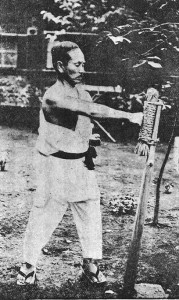
There are also some makiwara designs that are more portable, and one of these is what I decided to make first. (I’ll talk about some other styles later). The one I made is what I would call “semi-portable”, in that it can be moved from one room to another or taken outside, but it isn’t something you would transport from home to the dojo. There are versions of this style that can be taken apart for storage, but this one is permanently assembled and, in my case, will be stationed in my home dojo in the garage.
The idea behind this type of makiwara is that the striking post is affixed to a raised platform, with the user’s weight holding the platform down as the post is struck. The materials required are straightforward and are available at any hardware store:
- Plywood sheet (4′ x 3′)
- 2″ x 4″ boards for raising the platform and reinforcing the post
- 4″ x 4″ post
- Post bracket
- Misc. nuts, bolts, and screws
- A striking surface

The bracket was mounted using bolts down through the platform, plus some screws up through the bottom of the platform into the post inside the bracket. I also reinforced the front of the bracket using another piece of metal, as shown in the photo below.
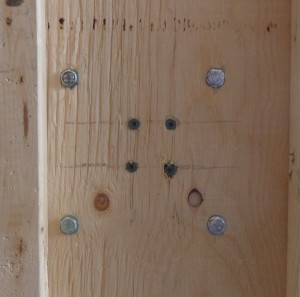
I also reinforced the front of the bracket using another piece of metal, as shown in the photo below. It’s bolted to the platform along with the bracket, and also screwed into the post through the bracket.
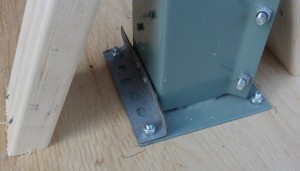
In addition, I reinforced both the front and back of the post using angled 2″ x 4″ pieces.

The final step was to add the striking surface. There are plenty of options for this, from the traditional straw rope or a modern equivalent, to a garden kneeling pad, to some foam and a piece of leather. The main criterion is that it provide enough padding that you will not injure your hands or feet but not so much that it absorbs all the force of the strike without allowing the board to flex. The point of the makiwara is NOT condition your knuckles by beating the heck out of them. Yes, you see traditional martial artists with huge callouses from using the makiwara, but this is a byproduct rather than the main purpose of training on a makiwara with a striking surface made of rope.
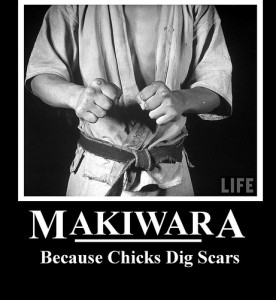
I intend to use the makiwara for improving technique and increasing power in my strikes (rather than impressing girls) and I don’t really want my hands to look abnormal, so more padding is good as far as I am concerned.
It so happened that I had my old sparring gear, which was in rather bad shape after being put through the wash, which fit quite nicely around the post. In traditional hoju undō (supplementary physical training), you use whatever you have access to, so I think this fits well with the spirit of the original makiwara.


If the plywood ends up being uncomfortable (assuming I use it with bare feet), I may add a little padding to the top. Otherwise, this makiwara seems to work pretty well and it’s nice to be able to use it either indoors or outside according to weather.
As I noted, there are many different designs for makiwara, so go ahead and explore online to find one that would work for you.
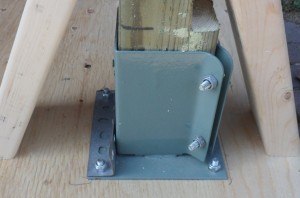



 Brazilian Jiu-Jitsu
Brazilian Jiu-Jitsu
 Kodokan Judo
Kodokan Judo



[…] })();TweetI discussed the purpose and various ways of manufacturing a makiwara in a previous post (Makiwara — platform type). The platform type that I built last time is good if you want to have a self-contained version of […]
[…] a Body Opponent Bag (“BOB“) as well as traditional implements for hojo undo like the makiwara. I mentioned that the tire-type makiwara that I made is particularly neat because it can be […]
[…] training (Metro Michigan Shotokan Karate) How to construct your own makiwara (FTSV Jahn Brinkum) * Makiwara — platform type (Back in the Gi) * Makiwara — tire type (Back in the Gi) * Ultimate Makiwara (plans for purchase) […]
Very good article and a nice design. I can’t believe this was up for over a year (closer to a year and a half) and I only ran across it today. I was happy to see you mention the use of the makiwara as structural feedback training and the role that progressive resistance plays in developing power and penetration. It is information I feel is truly vital yet it is all too rarely discussed. Have you personally noticed any improvements in structure and/or power from working with the makiwara?
Many people think it’s for conditioning knuckles. Sadly, I haven’t used this one as regularly as I should, but it does provide the right kind of progressive resistance.